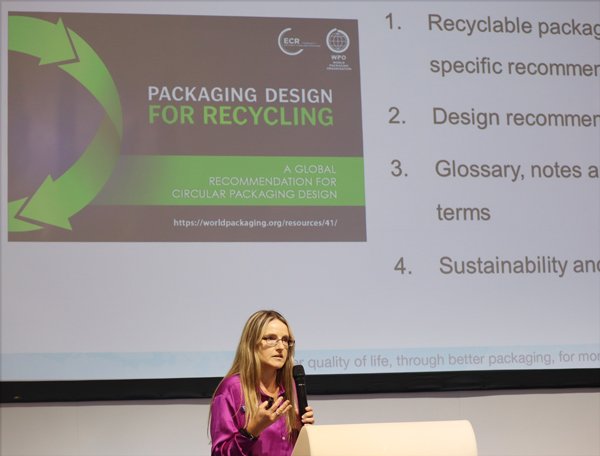
On 3 May 2022, the opening day of the Ipack-Ima, Pharmintech and Print4All exhibitions in Milan, the World Packaging Organisation held a press conference with president Pierre Pennar reiterating the WPO’s overall sustainability objectives. It also released, in conjunction with its Global Packaging Design Recycling Guide, the second stage of this effort – the Waste Stream Mapping Guides for 20 countries that have already systematically listed packaging materials technically, and their prospects of entering appropriate collection and recycling streams.

A global ‘Packaging Design for Recycling Guide’ has been developed by the WPO, Circular Analytics, FH Campus University of Applied Sciences and ECR Community. The global Packaging Design for Recycling Guide to be made accessible in all countries is currently available for download in English, German and Georgian. The plans is to eventually document its implementation in each country. It is a breakthrough for an industry in which recycling is too often an afterthought, and designers are seldom informed or educated at the beginning of the package creation process.
The ‘Packaging Design for Recycling Guide’ is seen as a starting point to understand best practice examples using state-of-the-art technology that can be applied and tailored to suit the recovery and recyclability capabilities and infrastructure on a regional and local level. To implement packaging waste recycling on a global scale, a practical and granular understanding of the solid waste collection, sorting and recycling streams is needed in each country.
Country-specific Waste Stream Mapping Guides
As the second stage of its packaging design for recycling effort, the WPO launched more than 20 country-specific Waste Stream Mapping Guides. Circular Design is only effective when the relevant collection, sorting and recycling streams exist. From the mapping of the waste streams we can better determine the technically recyclable packaging types in countries across the world.
A quick look at some of country guides shows these consist of a list of packaging materials and the respective levels of waste collection and recycling indicated from green to red. Generally the materials in the green category indicate that 60 to 80% of the waste stream for that material such as paper, aluminum and some polymers are readily collected and can be usefully recycled. The red bands seem to generally indicate that for certain materials such as flexible PS, flexible PVC and flexible PET, acceptable waste streams and recycling are not yet available.
There also categories that are indicated in the yellow band that can only be returned to specific programs and these often include liquid beverage cartons. All in all, it should not be difficult to prepare such a list for India, even if at first many of the materials may have to be considered in categories where there is some organized waste collection and recycling but perhaps not yet with the efficiency of the green category or are still, “under review.”
The country-wide Waste Stream Mapping Guides announced at the WPO press conference in Milan by Nerida Kelton executive director of the Australian Packaging Organization and vice president for Sustainability & Save Food at the WPO, are a part of the Global Packaging Design for Recycling Guide program. With plans to eventually document packaging recycling in each country, it is a welcome effort by an organization with a growing membership of over 60 countries. As Kelton remarked while releasing the guides, “Using these tools at the start of an NPD process will also bring significant opportunities to eliminate non-recyclable packaging before it is placed on the market.”
To apply recyclable packaging design guidelines, a certain fundamental knowledge of sorting and recycling processes is necessary. Packaging must, therefore, be suitable for state-of-the-art sorting and recycling processes in addition to its basic functions (e.g., storage, transport, product protection, product presentation and convenience). The Waste Stream Mapping Guides are essential global decision-making tools that will enable anyone, and particularly packaging designers and product managers to access current information on technically recyclable packaging across the world.
The guides also come with a ‘How to Use Guide’ for the Global Packaging Design Recycling Guide so that they can be used hand-in-hand when packaging is being designed. Design for recycling is part of circular product design and represents an important basis for holistic sustainability assessment.
Accordingly, circularity means that the packaging is designed in such a way that the highest possible recycling of the materials in use can be achieved. The goals here are resource conservation, the longest possible service life, material-identical recycling (closed-loop recycling) or the use of renewable materials.
Circular packaging should therefore be designed and manufactured in such a way that it can be reused (reusable solution) and/or that the raw materials used can be reused to a large extent as secondary raw materials after the use phase (recycling) and/or consist of renewable raw materials.
The country-specific waste stream mapping guides are available in the respective languages of the regions mapped and should be taught and used alongside the Global Guide that is available in English, German and Georgian. Each of the waste stream documents may be downloaded from the WPO website or here – Australia, Austria, Belgium, Brazil, Denmark, Finland, France, Germany, Greece, Hungary, Ireland, Japan, Luxembourg, Netherlands, New Zealand, Russia, Spain, Sweden, Switzerland, United Kingdom, and the United States.
The unique challenges of every country’s solid waste recycling streams cannot be emphasized enough. Products, culture, waste streams, laws, regulations and government efforts in each country vary and need to be acknowledged, understood and refined for recycling. Kelton indicated that active participation from the WPO member countries is sought for bringing out further country-wide guides in the appropriate languages.
Packaging Design for Recycling Guide (English Language)











